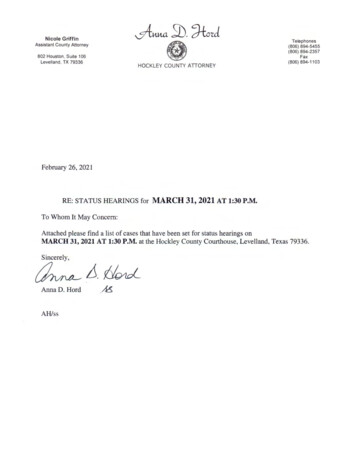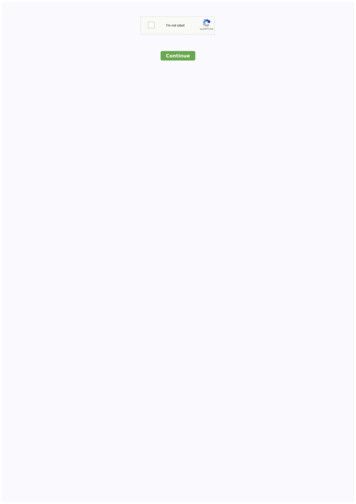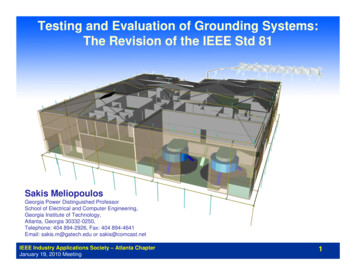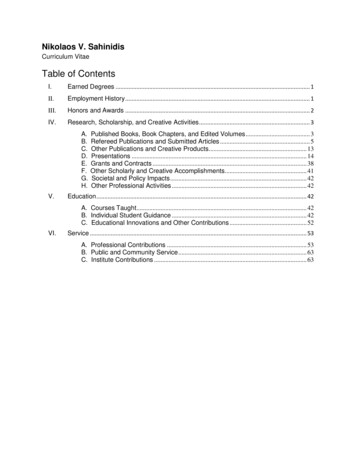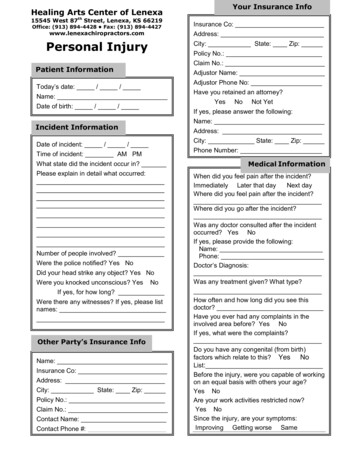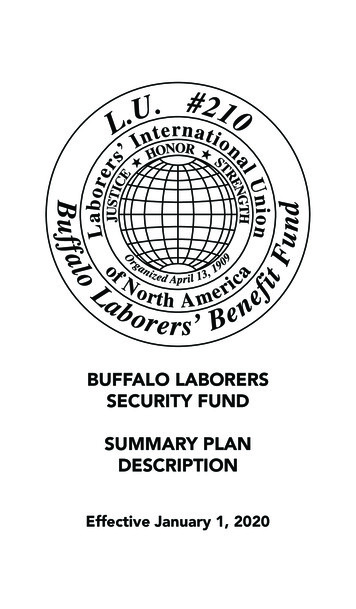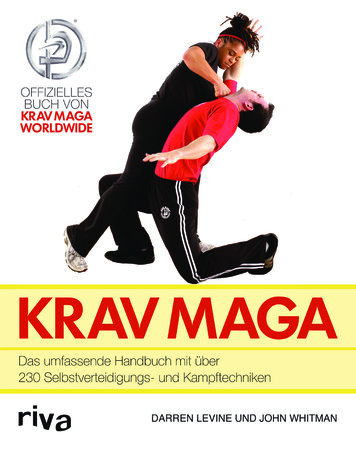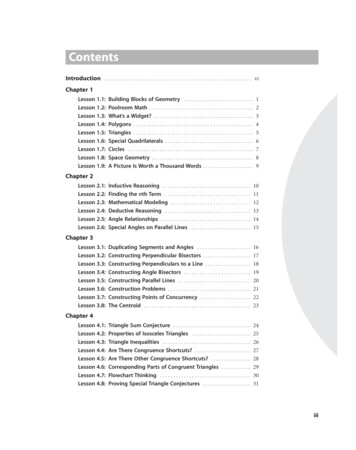
Transcription
DG4PSA 894 fm.qxd11/1/0611:16 AMPage iiiContentsIntroduction. . . . . . . . . . . . . . . . . . . . . . . . . . . . . . . . . . . . . . . . . . . . . . . . . . . . . . .viChapter 1Lesson 1.1:Lesson 1.2:Lesson 1.3:Lesson 1.4:Lesson 1.5:Lesson 1.6:Lesson 1.7:Lesson 1.8:Lesson 1.9:Building Blocks of Geometry . . . . . . .Poolroom Math . . . . . . . . . . . . . . . . . . . .What’s a Widget? . . . . . . . . . . . . . . . . . .Polygons . . . . . . . . . . . . . . . . . . . . . . . . . .Triangles . . . . . . . . . . . . . . . . . . . . . . . . . .Special Quadrilaterals . . . . . . . . . . . . . .Circles . . . . . . . . . . . . . . . . . . . . . . . . . . . .Space Geometry . . . . . . . . . . . . . . . . . . .A Picture Is Worth a Thousand Words. . . . . . . . . . . . . . . . . . . . . . . . . . . . . . . . . . . . . . . . . . . . . . . . . . . . . . . . . . . . . . . . . . . . . . . . . . . . . . . . . . . . . . . . . . . . . . . . . . . . . . . . . . . . . . . . . . . . . . . . . . . . . . . . . . . . . . . . . . . . . . . . . . . . . . . . . . . . . . . . . . .123456789Chapter 2Lesson 2.1:Lesson 2.2:Lesson 2.3:Lesson 2.4:Lesson 2.5:Lesson 2.6:Inductive Reasoning . . . . . . . . . .Finding the nth Term . . . . . . . . .Mathematical Modeling . . . . . . .Deductive Reasoning . . . . . . . . .Angle Relationships . . . . . . . . . . .Special Angles on Parallel Lines. . . . . . . . . . . . . . . . . . . . . . . . . . . . . . . . . . . . . . . . . . . . . . . . . . . . . . . . . . . . . . . . . . . . . . . . . . . . . . . . . . . . . . . . . . . . . . . . . . . . . . . . . . . . . . . . . . . . . . . . . . . . . . . . . . . . .101112131415Chapter 3Lesson 3.1:Lesson 3.2:Lesson 3.3:Lesson 3.4:Lesson 3.5:Lesson 3.6:Lesson 3.7:Lesson 3.8:Duplicating Segments and Angles . . .Constructing Perpendicular Bisectors .Constructing Perpendiculars to a LineConstructing Angle Bisectors . . . . . . . .Constructing Parallel Lines . . . . . . . . . .Construction Problems . . . . . . . . . . . . . .Constructing Points of Concurrency . .The Centroid . . . . . . . . . . . . . . . . . . . . . . . . . . . . . . . . . . . . . . . . . . . . . . . . . . . . . . . . . . . . . . . . . . . . . . . . . . . . . . . . . . . . . . . . . . . . . . . . . . . . . . . . . . . . . . . . . . . . . . . . . . . . . . . . . . . . . . . . . . . . . . . . . . . . . . .1617181920212223Chapter 4Lesson 4.1:Lesson 4.2:Lesson 4.3:Lesson 4.4:Lesson 4.5:Lesson 4.6:Lesson 4.7:Lesson 4.8:Triangle Sum Conjecture . . . . . . . . . . . . . . . . . .Properties of Isosceles Triangles . . . . . . . . . . .Triangle Inequalities . . . . . . . . . . . . . . . . . . . . . .Are There Congruence Shortcuts? . . . . . . . . . .Are There Other Congruence Shortcuts? . . . .Corresponding Parts of Congruent TrianglesFlowchart Thinking . . . . . . . . . . . . . . . . . . . . . . .Proving Special Triangle Conjectures . . . . . . . . . . . . . . . . . . . . . . . . . . . . . . . . . . . . . . . . . . . . . . . . . . . . . . . . . . . . . . . . . . . . . . . . . . . . . . . . . . . . . . .2425262728293031iii
DG4PSA 894 fm.qxd11/1/0611:16 AMPage ivChapter 5Lesson 5.1:Lesson 5.2:Lesson 5.3:Lesson 5.4:Lesson 5.5:Lesson 5.6:Lesson 5.7:Polygon Sum Conjecture . . . . . . . . . .Exterior Angles of a Polygon . . . . . .Kite and Trapezoid Properties . . . . .Properties of Midsegments . . . . . . . .Properties of Parallelograms . . . . . . .Properties of Special ParallelogramsProving Quadrilateral Properties . . . . . . . . . . . . . . . . . . . . . . . . . . . . . . . . . . . . . . . . . . . . . . . . . . . . . . . . . . . . . . . . . . . . . . . . . . . . . . . . . . . . . . . . . . . . . . . . . . . . . . . . . . . . . . . . . . . . . . . . . . . . . . . .32333435363738Chapter 6Lesson 6.1: Tangent Properties . . . . . . . . . . . . . . . . . . . . . . .Lesson 6.2: Chord Properties . . . . . . . . . . . . . . . . . . . . . . . . .Lesson 6.3: Arcs and Angles . . . . . . . . . . . . . . . . . . . . . . . . . .Lesson 6.4: Proving Circle Conjectures . . . . . . . . . . . . . . . . .Lesson 6.5: The Circumference/Diameter Ratio . . . . . . . . .Lesson 6.6: Around the World . . . . . . . . . . . . . . . . . . . . . . . .Lesson 6.7: Arc Length . . . . . . . . . . . . . . . . . . . . . . . . . . . . . . .Exploration: Intersecting Secants, Tangents, and Chords. . . . . . . . . . . . . . . . . . . . . . . . . . . . . . . . . . . . . . . . . . . . . . . . . . . . . . . . . . . . . . . . . . . . . . . . . . . . . . . . .3940414243444546Chapter 7Lesson 7.1: Transformations and Symmetry . . . .Lesson 7.2: Properties of Isometries . . . . . . . . . . .Lesson 7.3: Compositions of Transformations . .Lesson 7.4: Tessellations with Regular PolygonsLessons 7.5–7.8: Tessellations . . . . . . . . . . . . . . . . . . . . . . . . . . . . . . . . . . . . . . . . . . . . . . . . . . . . . . . . . . . . . . . . . . . . . . . . . . . . . . . . . . . . . . . . . . . . . . . . . . . . . . . . . . .4748495051Chapter 8Lesson 8.1:Lesson 8.2:Lesson 8.3:Lesson 8.4:Lesson 8.5:Lesson 8.6:Lesson 8.7:Areas of Rectangles and ParallelogramsAreas of Triangles, Trapezoids, and KitesArea Problems . . . . . . . . . . . . . . . . . . . . . . . .Areas of Regular Polygons . . . . . . . . . . . . .Areas of Circles . . . . . . . . . . . . . . . . . . . . . . .Any Way You Slice It . . . . . . . . . . . . . . . . . .Surface Area . . . . . . . . . . . . . . . . . . . . . . . . . . . . . . . . . . . . . . . . . . . . . . . . . . . . . . . . . . . . . . . . . . . . . . . . . . . . . . . . . . . . . . . . . . . . . . . . . . . . . . . . . . . . . . . . . . . . . . . . . . .52535455565758Chapter 9Lesson 9.1:Lesson 9.2:Lesson 9.3:Lesson 9.4:Lesson 9.5:Lesson 9.6:ivThe Theorem of Pythagoras . . . . . . . . . . . . . .The Converse of the Pythagorean TheoremTwo Special Right Triangles . . . . . . . . . . . . . . .Story Problems . . . . . . . . . . . . . . . . . . . . . . . . . .Distance in Coordinate Geometry . . . . . . . . .Circles and the Pythagorean Theorem . . . . . . . . . . . . . . . . . . . . . . . . . . . . . . . . . . . . . . . . . . . . . . . . . . . . . . . . . . . . . . . . . . . . . . .596061626364
DG4PSA 894 fm.qxd11/1/0611:16 AMPage vChapter 10Lesson 10.1:Lesson 10.2:Lesson 10.3:Lesson 10.4:Lesson 10.5:Lesson 10.6:Lesson 10.7:The Geometry of Solids . . . . . . . .Volume of Prisms and CylindersVolume of Pyramids and Cones .Volume Problems . . . . . . . . . . . . . .Displacement and Density . . . . .Volume of a Sphere . . . . . . . . . . . .Surface Area of a Sphere . . . . . . . . . . . . . . . . . . . . . . . . . . . . . . . . . . . . . . . . . . . . . . . . . . . . . . . . . . . . . . . . . . . . . . . . . . . . . . . . . . . . . . . . . . . . . . . . . . . . . . . . . . . . . . . . . . . . . . . . . . . . . . . . . . . . . . . . . . . . . . . . . . .65666768697071Chapter 11Lesson 11.1:Lesson 11.2:Lesson 11.3:Lesson 11.4:Lesson 11.5:Lesson 11.6:Lesson 11.7:Similar Polygons . . . . . . . . . . . . . . . . . . . . . . . . . . . .Similar Triangles . . . . . . . . . . . . . . . . . . . . . . . . . . . .Indirect Measurement with Similar Triangles . .Corresponding Parts of Similar Triangles . . . . .Proportions with Area . . . . . . . . . . . . . . . . . . . . . .Proportions with Volume . . . . . . . . . . . . . . . . . . . .Proportional Segments Between Parallel Lines. . . . . . . . . . . . . . . . . . . . . . . . . . . . . . . . . . . . . . . . . . . . . . . . . .72737475767778Chapter 12Lesson 12.1:Lesson 12.2:Lesson 12.3:Lesson 12.4:Lesson 12.5:Trigonometric Ratios . . . . . . . . . . . . . . . .Problem Solving with Right TrianglesThe Law of Sines . . . . . . . . . . . . . . . . . . .The Law of Cosines . . . . . . . . . . . . . . . . .Problem Solving with Trigonometry . . . . . . . . . . . . . . . . . . . . . . . . . . . . . . . . . . . . . . . . . . . . . . . . . . . . . . . . . . . . . . . . . . . . . . . . . . . . .7980818283Chapter 13Lesson 13.1:Lesson 13.2:Lesson 13.3:Lesson 13.4:Lesson 13.5:Lesson 13.6:Lesson 13.7:AnswersThe Premises of GeometryPlanning a Geometry ProofTriangle Proofs . . . . . . . . . .Quadrilateral Proofs . . . . . .Indirect Proof . . . . . . . . . . . .Circle Proofs . . . . . . . . . . . . .Similarity Proofs . . . . . . . . . . . . . . . . . . . . . . . . . . . . . . . . . . .84858687888990. . . . . . . . . . . . . . . . . . . . . . . . . . . . . . . . . . . . . . . . . . . . . . . . . . . . . . . . . . .91. . . . . . . . . . . . . . . . . . . . . . . . . . . . . . . . . . . . . . . . . . . . . . . . . . . . . . . . . . . . . . . . . . . . . . . . . . . . . . . . . . . . . . . . . . . . . . . . . . . . . . . . . . . . . . . . . . . . . . . . . . . . . . . . . . . . . . . . . . . . . . . . . . . . . . .v
DG4PSA 894 fm.qxd11/1/0611:16 AMPage viIntroductionThe author and editors of Discovering Geometry: An Investigative Approach areaware of the importance of students developing geometry skills along withacquiring concepts through investigation. The student book includes manyskill-based exercises. These Practice Your Skills worksheets provide problemssimilar to the introductory exercises in each lesson of Discovering Geometry. Likethose exercises, these worksheets allow students to practice and reinforce theimportant procedures and skills developed in the lessons. Some of these problemsprovide non contextual skills practice. Others give students an opportunity toapply geometry concepts in fairly simple, straightforward contexts. Some are morecomplex problems that are broken down into small steps.You might assign the Practice Your Skills worksheet for every lesson, or only forthose lessons your students find particularly difficult. Or, you may wish toassign the worksheets on an individual basis, only to those students who needextra help. One worksheet has been provided for nearly every lesson. There areno worksheets for Chapter 0, and the optional tessellation lessons have beencombined into two worksheets. To save you the time and expense of copyingpages, you can give students the inexpensive Practice Your Skills Student Workbook,which does not have answers. Though the copyright allows you to copy pagesfrom Practice Your Skills with Answers for use with your students, the consumablePractice Your Skills Student Workbook should not be copied. Students, parents, andmentors can also download the student worksheets from flourishkh.com.vi
DG4PSA 894 01.qxd11/1/061:26 PMPage 1Lesson 1.1 Building Blocks of GeometryNamePeriodDate 3 cm.For Exercises 1–7, complete each statement. PSPN is .1. The midpoint of PQQS2. NQ . is .3. Another name for NS .4. S is the of SQ5. P is the midpoint of . .6. NS is .7. Another name for SN8. Name all pairs of congruent segments in KLMN. Use theN8 cmcongruence symbol to write your answer.KOM8 cm . D has coordinates (6, 1). Find the9. M( 4, 8) is the midpoint of DELcoordinates of E.For Exercises 10 and 11, use a ruler to draw each figure. Label thefigure and mark the congruent parts. and CD with M as the midpoint10. AB . C is the midpoint of AB , with and CD11. AB12. Sketch six points A, B, C, D, E, and F, no13. In the figure below, {B, C, H, E} is a set of and CD . AB 6.4 cmof both ABand CD 4.0 cm. A, B, and C arenot collinear.three of which are collinear. Name the linesdefined by these points. How many linesare there? , is theAC 1.5 cm. D, not on AB midpoint of AE , with AD 2BC.four coplanar points. Name two other setsof four coplanar points. How many sets offour coplanar points are there?BCADFEGHCubeDiscovering Geometry Practice Your Skills 2008 Kendall Hunt PublishingCHAPTER 11
DG4PSA 894 01.qxd11/1/061:26 PMPage 2Lesson 1.2 Poolroom MathNamePeriodDateFor Exercises 1–5, use the figure at right to completeeach statement.B1. A is the of BAE.C is the of BAE.2. ADAD is a of DAE.3. AD4. If m BAC 42 , then m CAE .E5. DAB .OFor Exercises 6–9, use your protractor to find the measure ofeach angle to the nearest degree.6. m PRO7. m ORT8. m O9. m RTOPRTAFor Exercises 10–12, use your protractor to draw and then labeleach angle with the given measure.10. m MNO 15 11. m RIG 90 12. m z 160 For Exercises 13–15, find the measure of the angle formed by thehands at each time.13. 3:0014. 4:001112121015. 3:309348For Exercises 16 and 17, mark each figure with all the given information.76516. m ADB 90 , AD BD, DAB DBABADC17. m RPQ 90 , QR TZ, RT QZ, Q TRQ2PCHAPTER 1TZDiscovering Geometry Practice Your Skills 2008 Kendall Hunt Publishing
DG4PSA 894 01.qxd11/1/061:26 PMPage 3Lesson 1.3 What’s a Widget?NamePeriodDateFor Exercises 1–9, match each term with one of the items (a to i) below. 2a.b.?c.?90 1d.e.f.?g.h.i.P?QR1. Vertical angles2. Obtuse angle3. Right angle4. Complementary angles5. Congruent angles6. Linear pair of angles7. Bisected angle8. Perpendicular lines9. Congruent segments10. If m P 13 , m Q 77 , and Q and R are complementary, whatcan you conclude about P and R? Explain your reasoning.For Exercises 11–13, sketch, label, and mark a figure showingeach property.11. 1 2, 2 3Discovering Geometry Practice Your Skills 2008 Kendall Hunt Publishing PR 12. PQ13. BAC XAY, CX BCCHAPTER 13
DG4PSA 894 01.qxd11/1/061:26 PMPage 4Lesson 1.4 PolygonsNamePeriodDateFor Exercises 1–8, complete the table.Polygon nameNumber of sidesNumber of diagonals1. Triangle22.53.4. Hexagon5. Heptagon86.357.128.For Exercises 9 and 10, sketch and label each figure. Mark the congruences.9. Concave pentagon PENTA, with external10. Equilateral quadrilateral QUAD, with , and TA PE .diagonal ET Q U.For Exercises 11–14, sketch and use hexagon ABCDEF.11. Name the diagonals from A.12. Name a pair of consecutive sides.13. Name a pair of consecutive angles.14. Name a pair of non-intersecting diagonals.For Exercises 15–18, use the figures at right.MNOPQ RSTUVTO61 U15. m N 16.116. VR 17. m P 18. ON VQP8.47.2MN82 S58 R19. The perimeter of a regular pentagon is 31 cm. Find the length ofeach side.4CHAPTER 1Discovering Geometry Practice Your Skills 2008 Kendall Hunt Publishing
DG4PSA 894 01.qxd11/1/061:26 PMPage 5Lesson 1.5 TrianglesNamePeriodDateFor Exercises 1–5, use the figure at right. Name a pair of1. Parallel segmentsAB2. Perpendicular segments3. Congruent segmentsCDEF4. Supplementary angles5. Linear anglesGHIFor Exercises 6 and 7, sketch, label, and mark each figure.6. Isosceles obtuse triangle TRI with vertex angle T. , CA ,7. Scalene right triangle SCA with midpoints L, M, and N on SC , respectively.and SAFor Exercises 8 and 9, use your geometry tools to draw each figure.8. Acute isosceles triangle ACD with vertex9. Scalene right triangle RGH.angle A measuring 40 .For Exercises 10–12, use the graph at right.y10. Locate F so that ABF is a right triangle.C (8, 3)11. Locate D so that ABD is an isosceles triangle.12. Locate G so that ABG is scalene and not a right triangle.Discovering Geometry Practice Your Skills 2008 Kendall Hunt PublishingA (0, 0)B (8, 0)CHAPTER 1x5
DG4PSA 894 01.qxd11/1/061:26 PMPage 6Lesson 1.6 Special QuadrilateralsNamePeriodDateFor Exercises 1–6, sketch, label, and mark each figure.1. Parallelogram PGRA2. Square SQRE3. Rhombus RHOM with acute H. AP , RE PA ,4. Trapezoid TRAP with TR5. Kite KITE with EK KI and obtuse K.6. Rectangle RANG with perimeter 2a 4band P, E, and A collinear.For Exercises 7–10, name each polygon in the figure. Assume thatthe grid is square.HJIG7. Square9. RhombusFor Exercises 11–13, use the graph at right.8. ParallelogramD10. KiteAEBFCy11. Locate D so that ABCD is a rectangle.C (8, 3)12. Locate E so that ABCE is a trapezoid.13. Locate G so that points A, B, C, and GA (0, 0)B (8, 0)xdetermine a parallelogram that is nota rectangle.6CHAPTER 1Discovering Geometry Practice Your Skills 2008 Kendall Hunt Publishing
DG4PSA 894 01.qxd11/1/061:26 PMPage 7Lesson 1.7 CirclesNamePeriodFor Exercises 1–4, use the figure at right. 1. mQR2. mPR 3. mPQR4. mQPRDatePO48 Q5. Sketch a circle with an inscribed pentagon.R6. Sketch a circle with a circumscribedquadrilateral.7. A circle with center (3, 2) goes through( 2, 2). Give the coordinates of threeother points on the circle.y( 2, 2)8. Use a compass, protractor, and straightedge ; radiusto draw circle O with diameter AB OC with OC AB ; OD , the anglebisector of AOC, with D on the circle; and BC ; and a tangent at D.chords AC(3, 2)x9. Use a compass to construct a circle. Labelthe center P. Sketch two parallel tangents.Connect the points of tangency. What doyou notice about the chord?10. Use your compass and protractor to makean arc with measure 50 , an arc withmeasure 180 , and an arc with measure290 . Label each arc with its measure.11. Use your compass to construct two circles with different radii thatintersect in two points. Label the centers P and Q and the pointsof intersection A and B. Construct quadrilateral PAQB. What typeof quadrilateral is it?Discovering Geometry Practice Your Skills 2008 Kendall Hunt PublishingCHAPTER 17
DG4PSA 894 01.qxd11/1/061:26 PMPage 8Lesson 1.8 Space GeometryNamePeriodDateFor Exercises 1 and 2, draw each figure.1. A prism with a rectangular base.2. A cylinder with base diameter greaterthan height.For Exercises 3 and 4, sketch the three-dimensional figure formed byfolding each net into a solid. Name the solid.3.4.For Exercises 5 and 6, sketch the section formed when each solid is slicedby the plane as shown.5.6.7. The prism below is built with 1-cm8. Find the lengths of x and y.cubes. How many cubes are completelyhidden from sight, as seen from this angle?342yx8CHAPTER 14Discovering Geometry Practice Your Skills 2008 Kendall Hunt Publishing
DG4PSA 894 01.qxd11/1/061:26 PMPage 9Lesson 1.9 A Picture Is Worth a Thousand WordsNamePeriodDateRead and reread each problem carefully, determining what information youare given and what it is that you trying to find.1. A pair of parallel interstate gas and power lines run 10 meters apartand are equally distant from relay station A. The power companyneeds to locate a gas-monitoring point on one of the lines exactly12 meters from relay station A. Draw a diagram showing the locus ofpossible locations.2. The six members of the Senica High School math club are having agroup photo taken for the yearbook. The photographer has asked theclub to submit the height of each member so that he can quicklyarrange them in order. The math club sent him the followinginformation. Anica is 4 inches taller than Bruce. Charles is the sameheight as Ellen but an inch taller than Anica. Fred is midway betweenBruce and Dora. Dora is 2 inches taller than Anica. Help out thephotographer by arranging the club members in order from tallestto shortest.3. Create a Venn diagram showing the relationships among triangles,acute triangles, isosceles triangles, and scalene triangles.4. Sketch a possible net for each solid.a.Discovering Geometry Practice Your Skills 2008 Kendall Hunt Publishingb.c.CHAPTER 19
DG4PSA 894 02.qxd11/1/061:26 PMPage 10Lesson 2.1 Inductive ReasoningNamePeriodDateFor Exercises 1–7, use inductive reasoning to find the next two terms ineach sequence.1. 4, 8, 12, 16, ,2. 400, 200, 100, 50, 25, ,1 2 1 48 7 2 54. 5, 3, 2, 1, 1, 0, ,3. , , , , ,5. 360, 180, 120, 90, ,6. 1, 3, 9, 27, 81, ,7. 1, 5, 14, 30, 55, ,For Exercises 8–10, use inductive reasoning to draw the next two shapes ineach picture pattern.8.10.9.yyy(–1, 3)(3, 1)xxx(–3, –1)For Exercises 11–13, use inductive reasoning to test each conjecture.Decide if the conjecture seems true or false. If it seems false, givea counterexample.11. The square of a number is larger than the number.12. Every multiple of 11 is a “palindrome,” that is, a number that reads thesame forward and backward.13. The difference of two consecutive square numbers is an odd number.10CHAPTER 2Discovering Geometry Practice Your Skills 2008 Kendall Hunt Publishing
DG4PSA 894 02.qxd11/1/061:26 PMPage 11Lesson 2.2 Finding the nth TermNamePeriodDateFor Exercises 1–4, tell whether the rule is a linear function.1.n12345f(n)8152229363. nh(n)2.ng(n)12345 9 6 2394.nj(n)12345141185212345 32 1 12 01 2For Exercises 5 and 6, complete each table.5. n12346. n5f(n) 7n 1212345.50g(n) 8n 2For Exercises 7–9, find the function rule for each sequence. Then find the50th term in the sequence.7. n123456.91317212529.123456.61 4 9123456.6.577.588.59.f(n)8. ng(n)9. nh(n)n.50.n. 14 19 . . .50.n.50.10. Use the figures to complete the table.n123Number1of triangles5945.n.11. Use the figures above to complete the table. Assume that the area of thefirst figure is 1 square unit.n1 23 4Area offigure1 4 16Discovering Geometry Practice Your Skills 2008 Kendall Hunt Publishing5.n.50.CHAPTER 211
DG4PSA 894 02.qxd11/1/061:26 PMPage 12Lesson 2.3 Mathematical ModelingNamePeriodDate1. Draw the next figure in this pattern.a. How many small squares will there be in the10th figure?b. How many in the 25th figure?c. What is the general function rule for this pattern?2. If you toss a coin, you will get a head or a tail. Copy andHHcomplete the geometric model to show all possible results ofthree consecutive tosses.HTHHHHHTa. How many sequences of results are possible?Tb. How many sequences have exactly one tail?c. Assuming a head or a tail is equally likely, what is theprobability of getting exactly one tail in three tosses?3. If there are 12 people sitting at a round table, how many different pairsof people can have conversations during dinner, assuming they canall talk to each other? What geometric figure can you use to modelthis situation?4. Tournament games and results are often displayed using a geometricmodel. Two examples are shown below. Sketch a geometric model fora tournament involving 5 teams and a tournament involving 6 teams.Each team must have the same chance to win. Try to have as fewgames as possible in each tournament. Show the total numberof games in each tournament. Name the teams a, b, c . . . and numberthe games 1, 2, 3 . . . .aa1b313cb23 teams, 3 games(round robin)12CHAPTER 2cd24 teams, 3 games(single elimination)Discovering Geometry Practice Your Skills 2008 Kendall Hunt Publishing
DG4PSA 894 02.qxd11/1/061:26 PMPage 13Lesson 2.4 Deductive ReasoningNamePeriodDate1. ABC is equilateral. Is ABD equilateral? Explain your answer.BWhat type of reasoning, inductive or deductive, do you use whensolving this problem?CDA2. A and D are complementary. A and E are supplementary.What can you conclude about D and E? Explain your answer.What type of reasoning, inductive or deductive, do you use whensolving this problem?3. Which figures in the last group are whatnots? What type of reasoning,inductive or deductive, do you use when solving this problem?Whatnotsa.b.c.d.e.f.Not whatnotsWhich are whatnots?4. Solve each equation for x. Give a reason for each step in the process.What type of reasoning, inductive or deductive, do you use whensolving these problems?19 2(3x 1)a. 4x 3(2 x) 8 2xb. x 255. A sequence begins 4, 1, 6, 11 . . .a. Give the next two terms in the sequence. What type of reasoning,inductive or deductive, do you use when solving this problem?b. Find a rule that generates the sequence. Then give the 50th term inthe sequence. What type of reasoning, inductive or deductive, doyou use when solving this problem?Discovering Geometry Practice Your Skills 2008 Kendall Hunt PublishingCHAPTER 213
DG4PSA 894 02.qxd11/1/061:26 PMPage 14Lesson 2.5 Angle RelationshipsNamePeriodDateFor Exercises 1–6, find each lettered angle measure without usinga protractor.1.2.a112 3.a15 b c40 38 da70 4.e 132 d5.ccc6.abbabc70 110 ad e138 b100 25 For Exercises 7–10, tell whether each statement is always (A),sometimes (S), or never (N) true.7. The sum of the measures of two acute angles equals themeasure of an obtuse angle.8. If XAY and PAQ are vertical angles, then either X, A, and Por X, A, and Q are collinear.9. If two angles form a linear pair, then they are complementary.10. If a statement is true, then its converse is true.For Exercises 11–15, fill in each blank to make a true statement.11. If one angle of a linear pair is obtuse, then the other is .12. If A B and the supplement of B has measure 22 , thenm A .13. If P is a right angle and P and Q form a linear pair, thenm Q is .14. If S and T are complementary and T and U are supplementary,then U is a(n) angle.15. Switching the “if ” and “then” parts of a statement changes thestatement to its .14CHAPTER 2Discovering Geometry Practice Your Skills 2008 Kendall Hunt Publishing
DG4PSA 894 02.qxd11/1/061:26 PMPage 15Lesson 2.6 Special Angles on Parallel LinesNamePeriodDateFor Exercises 1–3, use your conjectures to find each angle measure.1.2.3.54 aaa65 bb54 cdcbFor Exercises 4–6, use your conjectures to determine whether 1 2,and explain why. If not enough information is given, write “cannotbe determined.”4.5.6. 1118 262 148 95 48 225 1 27. Find each angle measure.44 f78 e64 dcab8. Find x.9. Find x and y.4y 2 x3x 160 182 4x5x 2 Discovering Geometry Practice Your Skills 2008 Kendall Hunt PublishingCHAPTER 215
DG4PSA 894 03.qxd11/1/061:25 PMPage 16Lesson 3.1 Duplicating Segments and AnglesNamePeriodDateIn Exercises 1–3, use the segments and angles below. Complete theconstructions on a separate piece of paper.ABQPRS1. Using only a compass and straightedge, duplicate each segment andangle. There is an arc in each angle to help you.2. Construct a line segment with length 3PQ 2RS.3. Duplicate the two angles so that the angles have the same vertex andshare a common side, and the nonshared side of one angle falls insidethe other angle. Then use a protractor to measure the three angles youcreated. Write an equation relating their measures.4. Use a compass and straightedge to construct an isosceles triangle with and base congruent to CD .two sides congruent to ABABCD5. Repeat Exercise 4 with patty paper and a straightedge. .6. Construct an equilateral triangle with sides congruent to CDC16DCHAPTER 3Discovering Geometry Practice Your Skills 2008 Kendall Hunt Publishing
DG4PSA 894 03.qxd11/1/061:25 PMPage 17Lesson 3.2 Constructing Perpendicular BisectorsNamePeriodDateFor Exercises 1–6, construct the figures on a separate sheet of paper usingonly a compass and a straightedge.1. Draw a segment and construct its perpendicular bisector.2. Construct two congruent segments that are the perpendicular bisectorsof each other. Form a quadrilateral by connecting the four endpoints.What type of quadrilateral does this seem to be? . Then construct a segment with length 4 AB.3. Duplicate AB5AB . CM is a median of ABC. Construct4. Draw a segment; label it CM ABC. Is ABC unique? If not, construct a different triangle, as a median. A B C, also having CM . PQ is a midsegment of ABC. Construct5. Draw a segment; label it PQ ABC. Is ABC unique? If not, construct a different triangle, as a midsegment. A B C , also having PQ6. Construct a right triangle. Label it ABC with right angle B. Construct . Compare BD, AD, and CD.median BD7. Complete each statement as fully as possible.a. L is equidistant from .Eb. M is equidistant from .Dc. N is equidistant from .d. O is equidistant from .MALBDiscovering Geometry Practice Your Skills 2008 Kendall Hunt PublishingNOCCHAPTER 317
DG4PSA 894 03.qxd11/1/061:25 PMPage 18Lesson 3.3 Constructing Perpendiculars to a LineNamePeriodDateFor Exercises 1–5, decide whether each statement is true or false. If thestatement is false, explain why or give a counterexample.1. In a triangle, an altitude is shorter than either side from thesame vertex.2. In a triangle, an altitude is shorter than the median from thesame vertex.3. In a triangle, if a perpendicular bisector of a side and an altitudecoincide, then the triangle is isosceles.4. Exactly one altitude lies outside a triangle.5. The intersection of the perpendicular bisectors of the sides lies insidethe triangle.For Exercises 6 and 7, use patty paper. Attach your patty paper to yourworksheet.6. Construct a right triangle. Construct the altitude from the right angleto the opposite side.7. Mark two points, P and Q. Fold the paper to construct square PQRS.Use your compass and straightedge and the definition of distance tocomplete Exercises 8 and 9 on a separate sheet of paper. and CD .8. Construct a rectangle with sides equal in length to ABABCD9. Construct a large equilateral triangle. Let P be any point inside the equal in length to the sum of the distancestriangle. Construct WXfrom P to each of the sides. Let Q be any other point inside the equal in length to the sum of the distancestriangle. Construct YZfrom Q to each side. Compare WX and YZ.18CHAPTER 3Discovering Geometry Practice Your Skills 2008 Kendall Hunt Publishing
DG4PSA 894 03.qxd11/1/061:25 PMPage 19Lesson 3.4 Constructing Angle BisectorsNamePeriodDateᐉ21. Complete each statement as fully as possible.a. M is equidistant from .b. P is equidistant from .ᐉ1ᐉ3c. Q is equidistant from .MQPd. R is equidistant from .Rᐉ4ᐉ52. If the converse of the Angle Bisector Conjecture is true,what can you conclude about this figure?PCBA3. If BE bisects ABD, find x and m ABE.DE2x 10 A3x 20 BC4. Draw an obtuse angle
Lesson 1.2 Poolroom Math Name Period Date For Exercises 1–5, use the figure at right to complete each statement. 1. A is the _ of BAE. 2. AD is the _ of BAE. 3. AD is a _ of DAE. 4. If m BAC 42 , then m CAE _. 5. DAB _. For

